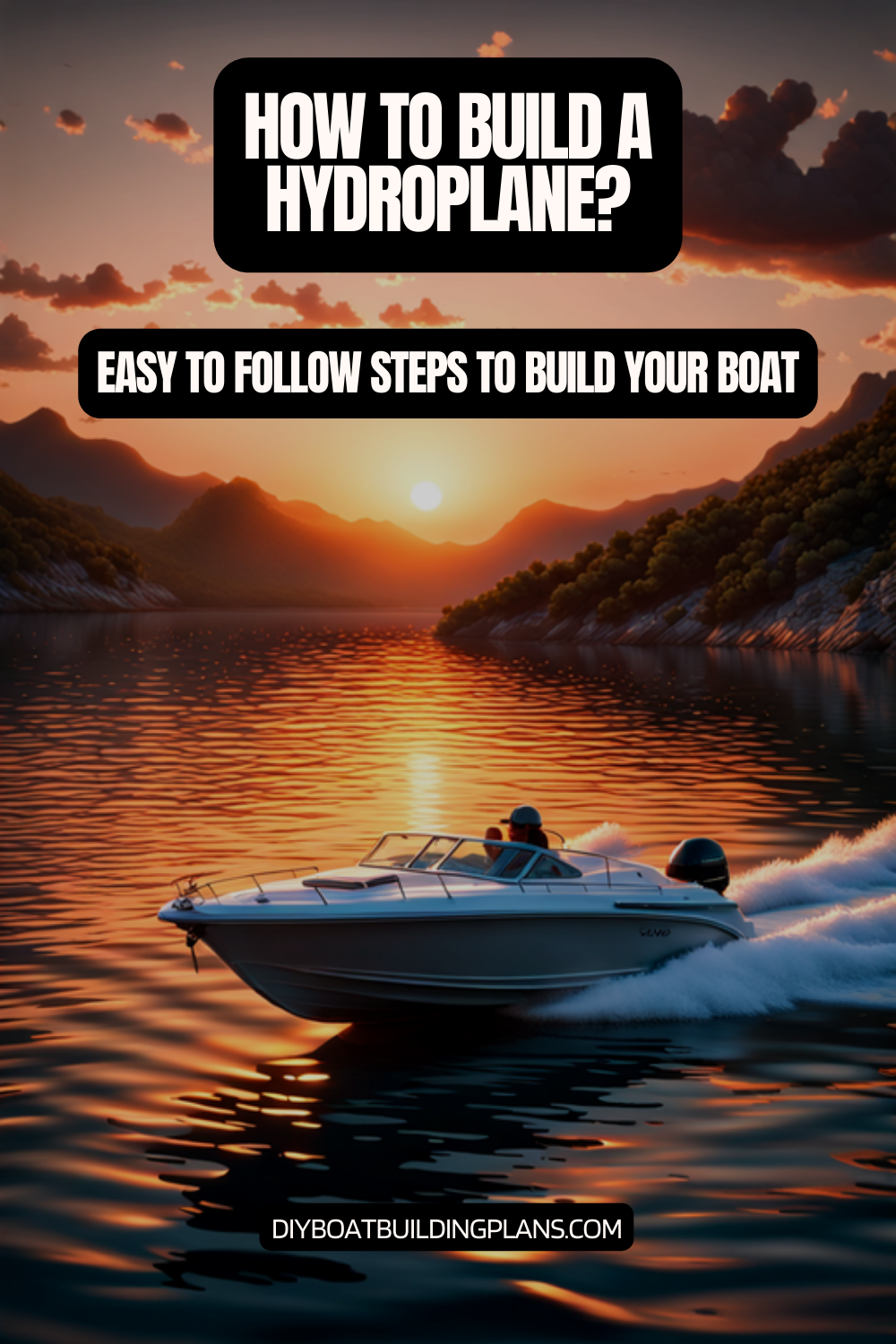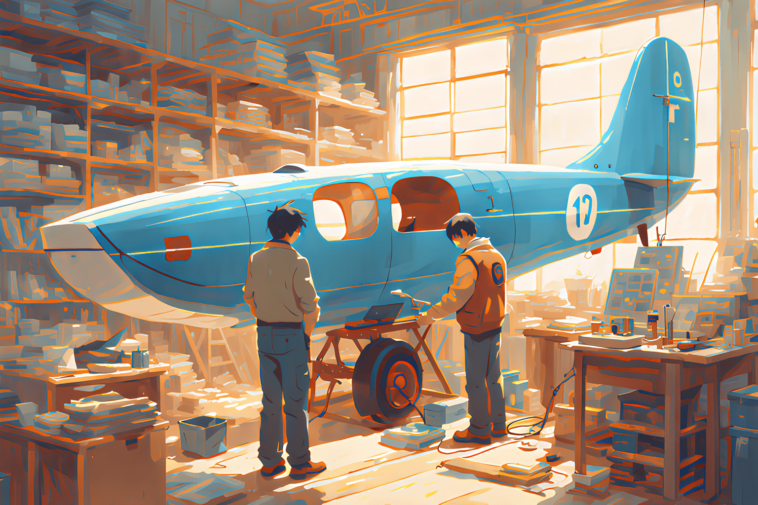Overview of How To Build a Hydroplane
Hydroplanes are a unique and fascinating type of watercraft that have captured the imagination of both enthusiasts and engineers alike. These high-speed boats, with their sleek and aerodynamic designs, are capable of skimming across the water’s surface, defying the laws of gravity and creating an exhilarating experience for their operators. In this comprehensive guide, we will delve into the world of hydroplanes, exploring their history, advantages, and the essential steps to build your own.
Hydroplanes, also known as planning boats, are a specialized type of watercraft that utilize the principles of hydrodynamics and aerodynamics to achieve remarkable speeds and maneuverability. These vessels are designed to lift a significant portion of their hull out of the water, reducing drag and allowing them to skim across the surface at astonishing velocities. The history of hydroplanes can be traced back to the early 20th century, when pioneering engineers and enthusiasts began experimenting with designs that could harness the power of water and air to create these high-performance boats.
The advantages of hydroplane technology are numerous and far-reaching. These vessels are capable of reaching speeds that far exceed those of traditional boats, making them ideal for racing, recreational activities, and even military and commercial applications. Hydroplanes are also highly maneuverable, allowing for tight turns and precise control, which is particularly useful in competitive settings. Additionally, their unique design and ability to lift out of the water can provide a more comfortable and stable ride, even in choppy conditions.
Key Takeaways
- Hydroplanes are high-speed boats that skim across the water’s surface.
- Understanding hydroplane design basics is crucial for building a successful hydroplane.
- Choosing the right materials is important for durability and performance.
- Constructing the hull and deck requires attention to detail and precision.
- Proper balancing and stabilizing are essential for safe and efficient hydroplane operation.

Understanding the Basics of Hydroplane Design
At the heart of a hydroplane’s design are the principles of hydrodynamics and aerodynamics. These scientific principles govern the way the boat interacts with the water and air, and understanding them is crucial for creating an effective and efficient hydroplane.
The key design elements of a hydroplane include the hull shape, deck configuration, and weight distribution. The hull shape is designed to minimize drag and maximize lift, often featuring a narrow, pointed bow and a flat, planing surface that allows the boat to skim across the water. The deck configuration, which includes the placement of the engine, seating, and other components, is carefully considered to ensure optimal weight distribution and balance. This balance is critical, as it affects the hydroplane’s stability, handling, and overall performance.
Achieving the perfect balance between hydrodynamics and aerodynamics is a delicate and intricate process, requiring a deep understanding of fluid mechanics and engineering principles. Hydroplane designers must carefully analyze the interactions between the water, air, and the various components of the boat, constantly refining and optimizing their designs to push the boundaries of speed and performance.
Selecting the Right Materials for Your Hydroplane
When it comes to building a hydroplane, the choice of materials is of paramount importance. The materials used must be strong, lightweight, and durable enough to withstand the immense forces and stresses encountered during high-speed operation.
Several factors must be considered when selecting the appropriate materials for your hydroplane. Strength is a critical requirement, as the boat must be able to withstand the tremendous forces exerted on it as it skims across the water. Weight is also a crucial factor, as a lighter boat will be more agile and responsive, with improved acceleration and top-end speed. Durability is another essential consideration, as the hydroplane must be able to withstand the harsh marine environment and the rigors of high-speed operation.
Common materials used in hydroplane construction include fiberglass, carbon fiber, and aluminum. Fiberglass is a popular choice due to its excellent strength-to-weight ratio, ease of fabrication, and relatively low cost. Carbon fiber, on the other hand, offers even greater strength and lower weight, but at a higher price point. Aluminum is also a viable option, providing a good balance of strength, weight, and cost-effectiveness.
When selecting the materials for your hydroplane, it is essential to carefully weigh the pros and cons of each option, considering factors such as cost, availability, and the specific requirements of your design. Consulting with experienced hydroplane builders and engineers can also provide valuable insights and guidance in making the right material choices.
Constructing the Hull and Deck
| Step | Description |
|---|---|
| 1 | Design the hydroplane using CAD software |
| 2 | Choose the materials for the hull, such as marine plywood or fiberglass |
| 3 | Construct the hull using the chosen materials |
| 4 | Install the engine and propeller |
| 5 | Install the steering and throttle controls |
| 6 | Test the hydroplane in a controlled environment, such as a lake or river |
| 7 | Make any necessary adjustments to improve performance |
Building the hull and deck of a hydroplane is a complex and intricate process that requires a high level of skill and attention to detail. The construction process typically involves a combination of molding, shaping, and assembly techniques to create the desired form and structure.
The first step in the construction process is to create a mold or plug, which will serve as the foundation for the hull and deck. This mold is typically made from a durable material, such as wood or high-density foam, and is carefully shaped to match the desired hull and deck design. Once the mold is complete, the next step is to apply the chosen construction material, such as fiberglass or carbon fiber, to the mold, using techniques like layup or vacuum bagging to ensure a strong and consistent structure.
After the hull and deck have been formed, the next step is to assemble the various components, including the transom, stringers, and other structural elements. This process requires precise measurements, careful alignment, and the use of specialized tools and adhesives to ensure a strong and seamless integration of the different parts.
Throughout the construction process, it is essential to maintain a high level of quality control, regularly inspecting the work and making any necessary adjustments to ensure that the final product meets the desired specifications and performance requirements. This attention to detail is crucial, as even minor flaws or inconsistencies in the hull and deck can have a significant impact on the hydroplane’s overall performance and handling.
Installing the Propulsion System
The heart of any hydroplane is its propulsion system, which is responsible for providing the power and thrust necessary to achieve the high speeds and impressive performance that these vessels are known for. Selecting the appropriate engine or motor for your hydroplane is a critical decision that requires careful consideration of factors such as power output, weight, and compatibility with the overall design.
When it comes to hydroplane propulsion, there are a few common options to choose from, including outboard motors, inboard engines, and electric motors. Outboard motors are a popular choice due to their relatively low cost, ease of installation, and the ability to adjust the thrust and trim for optimal performance. Inboard engines, on the other hand, offer a more integrated and streamlined design, but may require more complex installation and integration with the hull and deck.
Regardless of the propulsion system you choose, the key to success is ensuring a seamless integration with the overall hydroplane design. This involves carefully considering the placement and orientation of the engine or motor, as well as the integration of the drive train, propeller, and other related components. Proper alignment and balance are crucial, as any imbalances or misalignments can have a significant impact on the hydroplane’s handling and performance.
Throughout the installation process, it is essential to follow all manufacturer’s instructions and safety guidelines, as the propulsion system is a critical component that can pose serious risks if not installed and operated correctly. By taking the time to carefully plan and execute the installation of the propulsion system, you can ensure that your hydroplane is equipped with the power and performance it needs to excel on the water.
Balancing and Stabilizing Your Hydroplane
Achieving the perfect balance and stability in a hydroplane is a delicate and complex process that requires a deep understanding of the principles of physics and engineering. The hydroplane’s weight distribution and center of gravity play a crucial role in its overall performance, stability, and handling characteristics.
Proper weight distribution is essential for ensuring that the hydroplane remains stable and balanced during high-speed operation. This involves carefully positioning the various components, such as the engine, fuel tank, and seating, to achieve the optimal center of gravity. If the weight is not properly distributed, the hydroplane may become unstable, leading to poor handling, reduced performance, and potentially dangerous situations.
In addition to weight distribution, the hydroplane’s stability can also be enhanced through the use of various stabilization techniques, such as the incorporation of sponsons or hydrofoils. Sponsons are small, wing-like structures that extend from the sides of the hull, providing additional lift and stability, particularly at high speeds. Hydrofoils, on the other hand, are submerged, wing-like structures that lift the hull out of the water, reducing drag and improving stability and control.
Achieving the perfect balance and stability in a hydroplane is an iterative process that often requires extensive testing, adjustments, and fine-tuning. By carefully monitoring the hydroplane’s performance during water tests and making the necessary adjustments, you can ensure that your creation is stable, responsive, and capable of delivering an exhilarating and safe riding experience.
Testing and Troubleshooting Your Hydroplane
Once you have completed the construction of your hydroplane, the next critical step is to conduct thorough testing and troubleshooting to ensure that the vessel is performing as intended. This process involves a series of water tests and evaluations, during which you will assess the hydroplane’s speed, handling, stability, and overall performance.
During the initial water tests, it is essential to closely observe the hydroplane’s behavior, paying attention to any issues or problems that may arise. This could include instability, poor handling, excessive vibrations, or any other unexpected performance characteristics. By carefully documenting and addressing these issues, you can make the necessary adjustments and refinements to optimize the hydroplane’s performance.
One of the key aspects of troubleshooting a hydroplane is the ability to identify and address any imbalances or misalignments in the various components. This may involve adjusting the weight distribution, fine-tuning the propulsion system, or making modifications to the hull or deck design. By systematically addressing these issues, you can gradually improve the hydroplane’s performance and ensure that it is operating at its full potential.
Throughout the testing and troubleshooting process, it is crucial to maintain a meticulous record of your observations, adjustments, and the resulting performance changes. This information can be invaluable for future reference, allowing you to build upon your knowledge and experience to continuously refine and improve your hydroplane design.
Safety Considerations for Hydroplane Operation
Operating a hydroplane requires a high level of skill, knowledge, and safety awareness. These high-speed vessels can be incredibly thrilling to pilot, but they also come with inherent risks that must be carefully managed and mitigated.
One of the most important safety considerations for hydroplane operation is the use of proper safety gear and equipment. This includes the use of a life jacket, helmet, and other protective gear to safeguard the operator in the event of an accident or unexpected incident. Additionally, it is crucial to familiarize yourself with the navigational rules and regulations that govern the operation of watercraft in your local area, ensuring that you are operating your hydroplane in a responsible and legal manner.
Another key safety consideration is the importance of proper maintenance and inspection of the hydroplane. Regular checks and inspections of the various components, including the hull, deck, propulsion system, and safety equipment, can help to identify and address any potential issues before they become a problem. By staying vigilant and proactive in your maintenance efforts, you can help to ensure the continued safe operation of your hydroplane.
Ultimately, the safe operation of a hydroplane requires a combination of technical knowledge, practical experience, and a deep respect for the power and potential risks associated with these high-performance watercraft. By prioritizing safety and following best practices, you can enjoy the thrill of hydroplane operation while minimizing the risks and ensuring a safe and enjoyable experience for yourself and others.
Maintenance and Care for Your Hydroplane
Maintaining and caring for your hydroplane is essential to ensuring its long-term performance, reliability, and safety. Regular inspections, preventive maintenance, and proper storage and transportation are all critical components of a comprehensive hydroplane care regimen.
One of the most important aspects of hydroplane maintenance is the regular inspection of the various components, including the hull, deck, propulsion system, and safety equipment. This involves carefully checking for any signs of wear, damage, or deterioration, and addressing any issues that are identified. By staying on top of these inspections, you can help to prevent more serious problems from developing and ensure that your hydroplane is always ready for safe and reliable operation.
In addition to regular inspections, it is also important to perform routine maintenance tasks, such as cleaning, lubricating, and replacing worn or damaged parts. This may include tasks like cleaning the hull and deck, changing the engine oil, and replacing worn-out propellers or other components. By staying proactive with your maintenance efforts, you can help to extend the lifespan of your hydroplane and ensure that it continues to perform at its best.
When it comes to storage and transportation, it is essential to take the necessary precautions to protect your hydroplane from the elements and potential damage. This may involve storing the vessel in a dry, climate-controlled environment, or using specialized trailers or transport systems to safely move it from one location to another. By taking these steps, you can help to ensure that your hydroplane remains in top condition, even when it’s not in use.
By prioritizing maintenance and care for your hydroplane, you can help to ensure that it continues to provide you with the thrilling and reliable performance that you’ve come to expect. Whether you’re an avid racer or a recreational enthusiast, taking the time to properly maintain and care for your hydroplane is an essential investment in its long-term success and enjoyment.
Download over 500 Boat Plans. Click on the link below.
-->Click Here<--

Conclusion – How To Build a Hydroplane
In this article, you have learned how to build your own hydroplane in three parts. You have planned and designed your hydroplane, selected the right materials and tools, constructed and tested your hydroplane, and performed sea trials. You have also learned some tips and best practices from experts and experienced hydroplane builders.
Building a hydroplane is a rewarding and challenging project that requires creativity, skill, and perseverance. But the result is worth it: a unique and powerful watercraft that you can enjoy and be proud of. We hope this article has inspired you to start your own hydroplane building project.
FAQs – How To Build a Hydroplane
What is a hydroplane?
A hydroplane is a type of boat that is designed to skim across the surface of the water at high speeds.
What materials are needed to build a hydroplane?
The materials needed to build a hydroplane include marine plywood, epoxy resin, fiberglass cloth, marine paint, and various hardware such as screws, bolts, and nuts.
What tools are needed to build a hydroplane?
The tools needed to build a hydroplane include a jigsaw, circular saw, drill, sander, router, clamps, and various hand tools such as screwdrivers and wrenches.
What are the steps to build a hydroplane?
The steps to build a hydroplane include designing the boat, cutting and assembling the plywood pieces, applying epoxy resin and fiberglass cloth to the hull, sanding and painting the boat, and installing the hardware and engine.
How long does it take to build a hydroplane?
The time it takes to build a hydroplane depends on the complexity of the design and the builder’s skill level. It can take anywhere from a few weeks to several months to complete a hydroplane.
What is the cost to build a hydroplane?
The cost to build a hydroplane varies depending on the materials used and the size and complexity of the design. It can range from a few hundred dollars to several thousand dollars.
What are some safety precautions to take when operating a hydroplane?
Some safety precautions to take when operating a hydroplane include wearing a life jacket, following all boating laws and regulations, checking the weather conditions before heading out, and maintaining the boat and engine properly.



